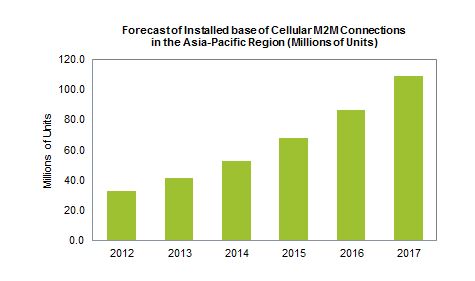Austin, Texas (May 5, 2014)—With cellular machine-to-machine (M2M) connections in Asia expected to more than triple in the coming years, local wireless operators have banded together in a group dedicated to facilitating M2M deployments in the region.
The installed base of wireless M2M connections in the Asia-Pacific (APAC) region will rise to 109.0 million in 2017, up from 32.6 million in 2012, according to IHS Technology (NYSE: IHS). By 2017, Asia-Pacific is set to be the second-largest regional M2M market, behind only Europe in total cumulative cellular M2M connection volume.
The figure presents the IHS forecast of cellular M2M connections in Asia-Pacific.

In January, 11 operator members of the Bridge Alliance in the Asian-Pacific region formed the Bridge M2M Alliance. The group was chartered to promote the growth of cellular M2M services in APAC.
The 11 founding Bridge M2M Alliance operators were Airtel of India, AIS of Thailand, CSL of Hong Kong, Globe of the Philippines, Maxis of Malaysia, MobiFone of Vietnam, Optus of Australia, SingTel of Singapore, SK Telecom of South Korea, Taiwan Mobile of Taiwan and Telkomsel of Indonesia. Together, these companies provide connectivity to more than 570 million mobile subscribers in the Asia-Pacific region.
The Bridge M2M Alliance will specifically address market inhibitors unique to the Asia-Pacific region.
“There are some fundamental structural challenges to the growth of multinational M2M deployments in Asia-Pacific that don’t impact other regions to the same extent,” said Bill Morelli, associate director of M2M & Internet of Things at IHS. “These problems include an overabundance of cellular air standards, major geographical barriers, and highly divergent market dynamics in different countries. The Bridge M2M Alliance could play a key role in overcoming these issues and enabling the region to attain its growth potential.”
Asia-Pacific boasts a plethora of cellular air interface standards, including CDMA, WCDMA, TD-SCDMA, and TD-LTE. This diversity makes the value proposition of a multinational deployment, either to enable one device to travel among several countries or to enable on stock-keeping unit (SKU) of a device to be shipped to multiple countries, harder to attain.
This diversity is not present in other regions to the same degree. Europe, for example, has largely standardized on GSM, WCDMA and FD-LTE.
Also, compared to regions, Asia-Pacific has more countries separated by large bodies of water, which reduces opportunities for connected devices to travel from country to country. For example, there is little chance that long-haul truck fleets will need to be tracked from South Korea traveling to China or from Australia to Japan. This situation is in contrast, again, to Europe, or North America, where there is significant movement via direct land borders.
Finally, major country-level M2M markets in Asia-Pacific are developing along more individual lines from one another than is the case in other regions.
For example, M2M in China is heavily state-driven, with strong government support for the Internet of Things and smart-city development. This parallels the country’s growing connected-car market, which is more market driven.
South Korea, in comparison, is relatively more focused on consumer connected devices and smart home applications, while the Japanese M2M market is diverse, ranging from smart-vending machines to connected cars. In contrast, the M2M markets in North America and Europe tend to be more homogenous, facilitating multinational deployments.
Despite these significant structural barriers, IHS believes there is little doubt that rapid growth will occur in multinational M2M deployments in APAC. To the extent that such deployments occur, the Bridge M2M Alliance is beneficial. Key benefits are a harmonization in commercial terms—such as service-level agreements (SLAs) and customer support, technical interoperability between different operators’ platforms and the joint development of a supporting ecosystem of technology vendors.
Advertisement
Learn more about IHS iSuppli





